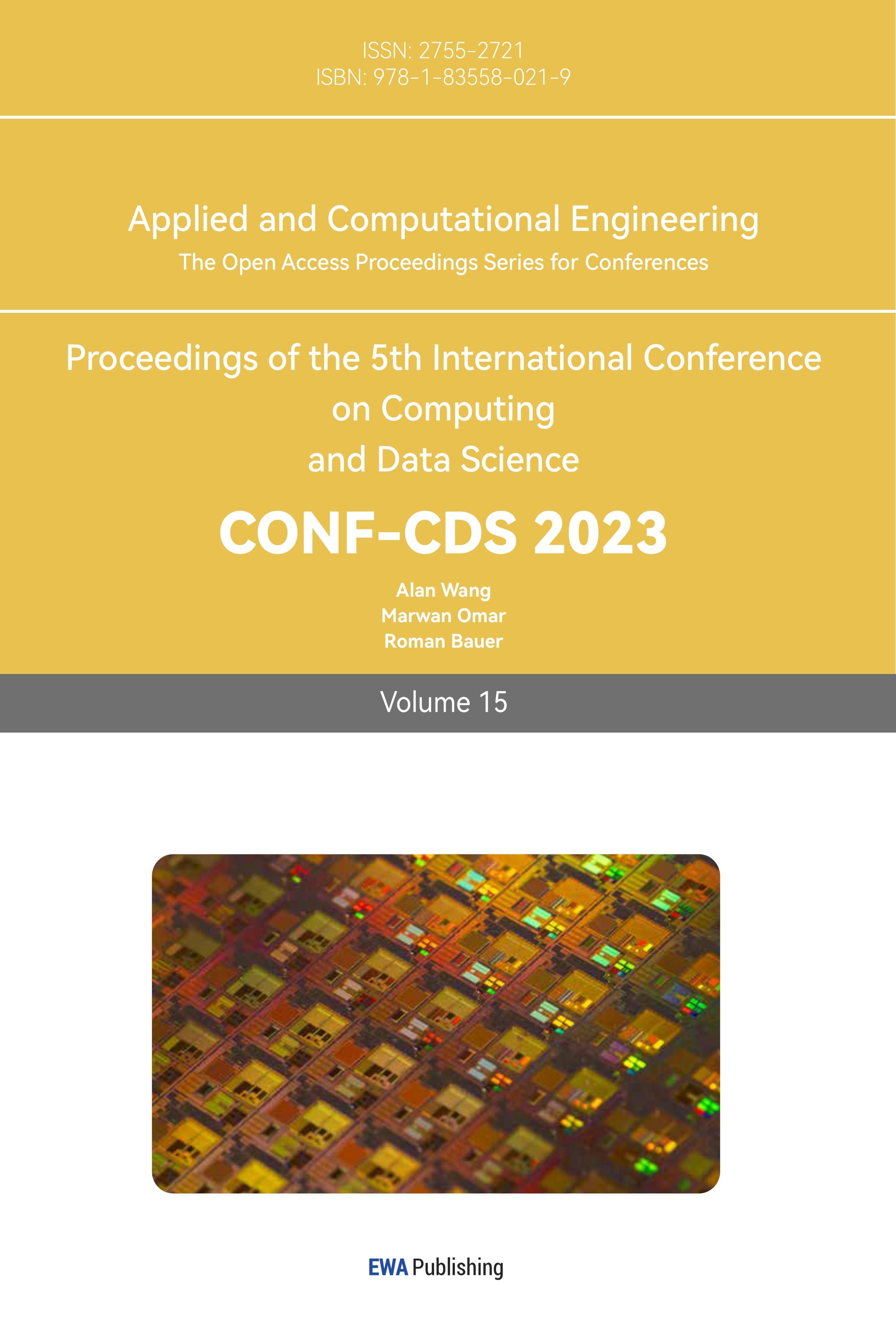1. Introduction
In recent years, Internet information and film websites have exploded, and film and television resources are unusually rich. However, various movies and television cannot be effectively integrated, which leads to so much information and makes it hard for people to quickly find the movies they like. To this end, how to accurately recommend the desired movie from the massive film and television resources has become a challenge, attracting a large amount of research interest from academia and industry. Accurate movie recommendation not only brings convenience to users, but also brings more profits and traffic to movie websites.
In the current digital era, recommendation plays an import role in our daily life, which aims at predicting the user choices and produce results according to user preference. According to the difference of algorithm designing, the existing recommendation systems are usually divided into recommender based on collaborative filtering, content, and Hybrid methods [1,2,3]. Content-based recommendation manage to list items similar to what users favored in the history as a result [4]. The text of items, like description and category, is then transformed into an unordered bag of words and the examples represented as a vector of words [5]. Then, items will be recommended based on the similarity of contexts and attributes. In common cases, this kind of systems are used when there is abundant attribute information [6]. Therefore, other users play little role in this way. Unlike Content-based approach, Collaborative Filtering relies on the \( m×n \) user-item matrix, which contains \( m \) users and \( n \) items, to leverages the ratings of other users and calculate the similarities between items. The basic idea behinds it is that similar items receive similar ratings. Some famous systems, like Ringo/Firefly [7] and Recommender [8], are using this technique.
If used in isolation, these two approaches have their own shortcomings. For collaborative filtering, it may encounter problems like the sparsity and cold start. As for the content-based method, it just recommends items similar to what users have rated, leading to less novelty. For years, researchers have been exploring the hybrid technique to eliminate many of the weakness of each approach. Fab designs a partial hybridization approach. In this way, content-based methods are used to classify the peer group, while the ratings are leveraged in the recommendation process [6]. In recent years, more advanced techniques have been developed. For example, a hybrid recommendation approach for articles, introduced by Wang et al. [9], manages to incorporate social tag and friend information in scientific social network. A hybrid scholarly recommendation method, proposed by Sakib,N. et al.[10] integrates metadata in scientific papers. Other methods include hybrid collaborative filtering model integrating deep presentation learning and matrix factorization [11], recommendation algorithm combining user trust network with probability matrix factorization [12], and so on.
In this paper, we try to combine the content-based and collaborative filtering methods to recommend movies and TVs. The remaining section of this paper is organized as follows. The overall architecture of our design is given in Section II. Section III introduces the whole procedure of our approach in details. Finally, evaluation and future works are presented in Section IV.
2. Method
2.1. General system architecture
In this study, we try to use content-based together with collaborative filtering by averaging the similarity scores calculated with these two approaches. We manage to make full use of the advantages of content-based filters and reduces the effects of their shortcomings. Figure 1 depicts the procedure of our proposed method. For the metadata, which is about the detailed information about the movies and TVs, we use text mining approach to transform it into vectors in high dimensional space. For the ratings, we apply Truncated SVD method to it, just like in the content-based phrase, to reduce the dimensionality for efficiency when reserving as much important information as possible. Then, using the two matrices generated respectively, we calculate the similarities between movies. For final recommendation, we combine the similarity results by computing and ranking the average of them and return a list of top-10 similar movies as recommendations.
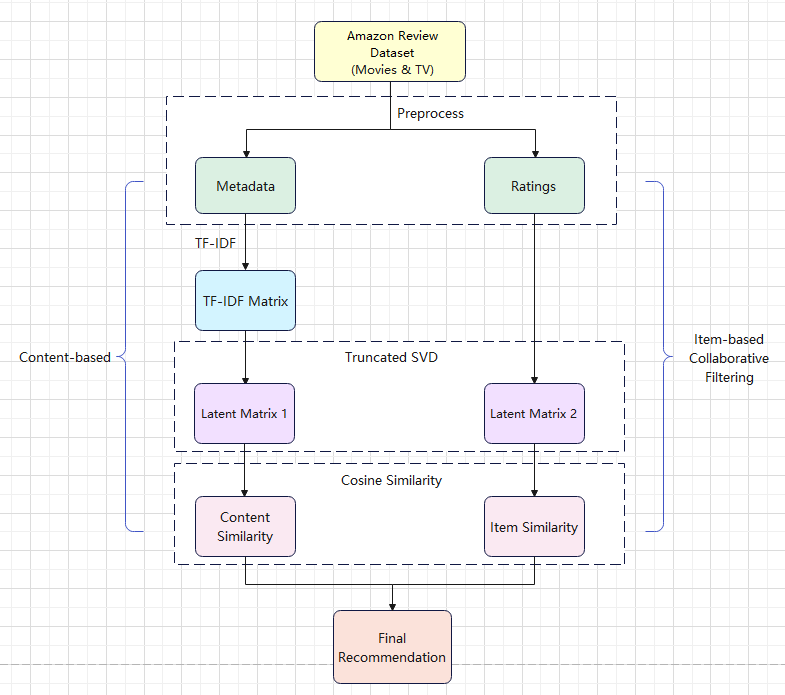
Figure 1. Overall Architecture of System.
2.2. Original datasets
In the project, the recommendation system is designed based on the metadata and over 8 million ratings of about 20 thousand Movies and TVs, which are subsets of the complete Amazon review dataset (2018) [1]. The product metadata include 19 attributes like descriptions, category information, price, brand and so on. And ratings are recorded with user ID, product ID and time. Parts of these two datasets are shown in Table 1 and 2.
Table 1. Rating dataset.
user | item | rating | timestamp | |
0 | A3478QRKQDOPQ2 | 0001527665 | 5.0 | 1362960000 |
1 | A2VHSG6TZHU1OB | 0001527665 | 5.0 | 1361145600 |
2 | A23EJWOW1TLENE | 0001527665 | 5.0 | 1358380800 |
Table 2. Metadata dataset of movies and TVs.
category | description | title | brand | |
0 | [Movies & TV, Movies] | [Disc 1: Flour Power (Scones;Shortcakes;…)] | My Fair Pastry (Good Eats Vol.9) | Alton Brown |
1 | [Movies & TV, Movies] | [Barefoot Contessa Volume 2: On these three…] | Barefoot Contessa (with Ina Garten),… | Ina Garten |
2 | [Movies & TV, Movies] | [Rise and Swine (Good Eats Vol.7) includes…] | Rise and Swine (Good Eats Vol.7) | Alton Brown |
2.3. Data preprocessing
Though there are quite a few records in the dataset, many of them are redundant with same information. Therefore, the first step we carried out was to drop the duplicated records. Then, since we are trying to apply the content-based method to the metadata of movies and TVs, we need to clean the columns which contain useful context, but the original structure is inappropriate. In our practice, columns of “category” and “description” are chosen to generate the “Bag of words” for each product. All punctuations are removed, and all terms are transformed into lowercase letters. After that, for convenience, we just reserve the cleaned columns. In our practice, except for the ID, title and bag of words, other columns have been dropped. The final cleaned metadata of movies and TVs are in Table 3.
Table 3. Cleaned metadata of movies and TVs.
item | title | Bag_of_words |
0000695009 | Understanding Seizures and Epilepsy | movies |
0000143529 | My Fair Pastry (Good Eats Vol.9) | disc1 flour power scones shortcakes… |
0000143592 | Rise and Swine (Good Eats Vol.7) | rise and swine good eats vol7 includes… |
Similar operations are also carried out on the rating dataset, which contains lots of repeated records. Besides, for time-sequential effects are not taken into consideration in our simple model, we drop the column of “timestamp” as well. Using the cleaned datasets, a larger table can be generated, containing all the information needed in our analysis in later phase. Note that because of the large size of the complete dataset, we just select 20000 records for training. Table 5 shows part of the final table.
Table 4. Final table after merging.
item | title | Bag_of_words | |
3911304 | B002DLB1IO | Anvil: The Story of Anvil | at 14 toronto school friends steve lips… |
1035588 | 6305476098 | The Confession | hired to defend a client who killed to… |
3463376 | B001AQR3LC | The Tudors: Season 3 | henry tudor must overcome his despair… |
From the merged table, we can get some rough information about the users and products. Surprisingly, most of the users have ratings that are less than five, while the most active one has commented on over 4000 movies. The distribution of users’ ratings is shown in Table 5.
Table 5. Distribution of users’ ratings.
Quantile | 25% | 50% | 75% | Max |
Ratings | 1 | 1 | 2 | 4254 |
Besides, we also manage to find out 20 most active users, and the results are depicted in Figure 2. From the bar chart, we can see that the number of ratings of the top 1 user is almost twice as many as that of the second one. And for the users followed, the figures just decrease steadily.
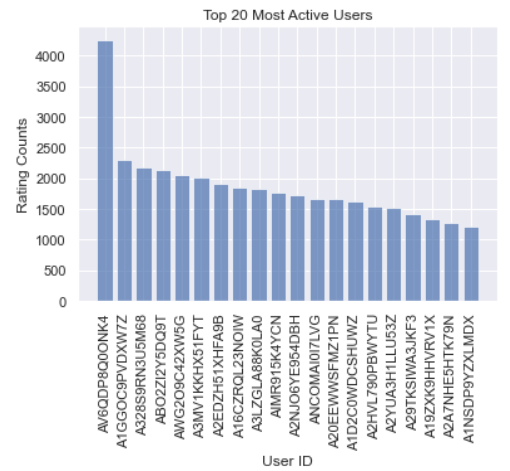
Figure 2. Top 20 Users.
Similarly, we explore the movies data. The results are shown in Table 6 and Figure 3. It seems that though over half of the movies have few ratings, the works Band of Brothers is really popular among the users, with about 50,000 ratings in total.
Table 6. Distribution of movies’ ratings.
Quantile | 25% | 50% | 75% | Max |
Ratings | 2 | 4 | 17 | 24543 |
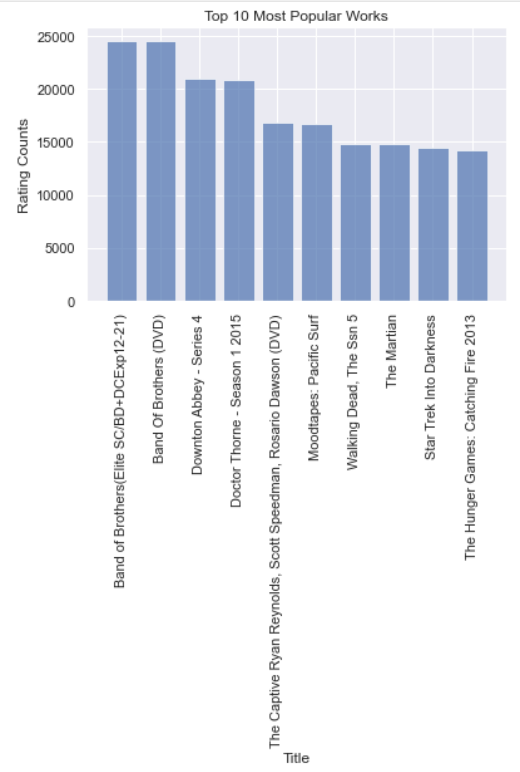
Figure 3. Top 10 Movies.
2.4. Content-based analysis
In our project, metadata is used in this phase. The categories and descriptions are the sources for generating the “bags of words”. By removing useless information like punctuation and stop words in data preprocessing, we can get cleaned data prepared for analysis.
2.4.1. TF-IDF vectorization. Nowadays, TF-IDF (Term frequency-inverse document frequency) is one of the most famous term weighting schemes in the field of text mining. It has been used to measure word relatedness [13]. If one specific term appears really frequently in the document set, it will be assumed as a more common term which is less helpful to distinguish one document from the others. However, if it just appears in one document frequently, it is more likely to be regarded as the keyword of the document, and it should be more weighted.
In this approach, for a set of documents which contains \( m \) terms in total, a document \( D \) is transformed to an \( m \) -dimensional vector, and each dimension represents a term. Using TF-IDF, the term weight is calculated as:
\( {w_{i}}={tf_{i}}×log{(\frac{n}{{df_{i}}}}) \) (1)
Where \( n \) documents are in the set, \( {tf_{i}} \) represents the times of appearance of term \( {t_{i}} \) in document \( D \) and \( {df_{i}} \) is the number of documents in which term \( {t_{i}} \) occurs [14].
Using Tf-idf Vectorizer from Python, we can get a \( 10610×61703 \) matrix with rows of movies and columns of terms. Table 7 shows parts of the result. Since the complete matrix is too large to operate calculation on it, for the next step we use the truncated SVD to reduce its dimension.
Table 7. TF-IDF matrix for movies.
0 | 1 | 2 | 3 | 4 | |
3911304 | 0.0 | 0.040343 | 0.0 | 0.0 | 0.0 |
1035588 | 0.0 | 0.000000 | 0.0 | 0.0 | 0.0 |
3463376 | 0.0 | 0.000000 | 0.0 | 0.0 | 0.0 |
2.4.2. Truncated SVD. SVD (Singular Value Decomposition) is a popular method of dimensionality reduction [4]. It shrinks the space dimension from \( N \) to \( K \) \( (K \lt N) \) . For the \( n×d \) matrix \( M \) , SVD decomposes it into three other matrices:
\( M=UΣ{V^{T}} \) (2)
Where \( Σ \) is an \( k×k \) diagonal matrix with nonnegative elements, \( U \) and \( V \) are \( n×k \) and \( d×k \) matrix respectively, and both of them consist of orthonormal columns. In this way, the value \( k \) is the rank of \( M \) [15].
2.5. Item-based collaborative filtering
For the ratings data, since the unnecessary column has been removed in the data preprocessing, now we just consider the problem of its large size. After transforming it into pivot table, it is in the format of user-item rating matrix, which is shown in Table 8. As we can see in the table, usually the rating matrix is sparse, containing lots of zeros.
Table 8. User-item Rating Matrix.
user item | A0019420MGJRFO7TA5QC | A0283642BURXFWRSJIJT |
0005019281 | 0.0 | 0.0 |
0005119367 | 0.0 | 0.0 |
0307142493 | 0.0 | 0.0 |
2.6. Final recommendation
In item-based recommendation approaches, cosine similarity is usually used to measure how related two items are. Transformed into a high dimensional space, these two vectors’ similarity is calculated based on the angle between them. In the fields of information retrieval and text mining, text documents, which are represented as vectors of terms, are also compared in this way [1]. The formula to calculate cosine similarity is:
\( sim(\vec{a},\vec{b})=\frac{\vec{a}∙\vec{b}}{|\vec{a}|×|\vec{b}|} \) (3)
In our process, we calculate the cosine similarity of movies in the two matrices respectively. The content-based matrix shows how movies are similar in context, while collaborative filtering matrix sees them from a different perspective based on ratings they get. And in the final phrase, the similarities computed in two ways will be combined to give the recommendations. As a really primitive model, we just use the average of them for ranking the items.
3. Experiments and performance analysis
3.1. Evaluation metrics
Instead of predicting rating values of the users, our model ranks \( t \) items for users and recommend top-k items. The length of the recommended list becomes rather important. If the list is short, the user may miss relevant items and we will lose potential customers. In this case, it is called false-negative. However, if the list is really long, the user may be bored with so many repeated and irrelevant recommendations(false-positive).
Therefore, to evaluate the accuracy of this model, we use the indicators like precision, recall and F1-score. To calculate the indicators mentioned above, first let us think of a recommendation list with \( t \) items and denote the set of the recommended items as \( S(t) \) , and the true set of relevant items as \( G \) . Then, the precision will be calculated as follows [6]:
\( Precision(t)=\frac{|S(t)∩G|}{|S(t)|} \) (4)
And the recall is defined as:
\( Recall(t)=\frac{|S(t)∩G|}{|G|} \) (5)
To make a trade-off between them, \( {F_{1}}-score \) is calculated as:
\( {F_{1}}=\frac{2×Precision(t)×Recall(t)}{Precision(t)+Recall(t)} \) (6)
In our project, \( S(t) \) is the list of recommended movies, and \( G \) refers to all movies seen by audience of the given input. We randomly select 500 movies to evaluate the performance of top-10 recommendation list, and the evaluation function will return the average \( {F_{1}} \) score of them. In our test, we get the result as around 0.94.
3.2. Effectiveness of Truncated SVD
To evaluate the performance of Truncated SVD, we conduct several experiments to see the performance of Truncated SVD on TF-IDF Matrix. Truncated SVD produces the closest rank-k approximation of a given input matrix [16]. Unlike the regular SVD, it can generate a factorization where the number \( K \) of columns can be specified (usually \( K \lt rank(M) \) ). In practice, we use this method to extract the most representative features. Setting the parameter \( K \) as 3000, its performance is shown in Figure 4. It can be observed that majority of the original information can be reserved.

Figure 4. Performance of Truncated SVD on TF-IDF Matrix.
Similarly, Truncated SVD is also used in collaborative filtering analysis, with the parameter set as 3000. Its performance is illustrated in the Figure 5. All the results demonstrate the necessary of introducing the Truncated SVD into our method.
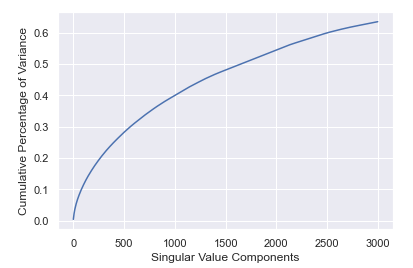
Figure 5. Performance of Truncated SVD on User-Item Matrix.
3.3. Performance analysis
For test, we input the ballet drama “The Flames of Paris” to this model, hoping to find its related works. And the recommendation list provided is in Table 9. Obviously, they are all related with ballet.
Table 9. The Recommended Movies.
Movie | Content Based | Collaborative | Final |
Ballet 422 | 0.513553 | 3.422993e-07 | 0.256777 |
Ballet 201, Beyond the Basics-VHS | 0.492126 | -1.441504e-04 | 0.245991 |
Tchaikovsky-The Nutcracker/Maximova, Vasiliev, Boishoi VHS | 0.450763 | -1.353671e-04 | 0.225314 |
Prima Princessa Presents Swan Lake | 0.445547 | -1.333689e-03 | 0.222107 |
The Red Shoes | 0.440672 | -3.417913e-04 | 0.220165 |
New York City Ballet Workout VHS | 0.437733 | -1.021616e-03 | 0.218356 |
Balanchine Library-Balanchine Essays-Arabesque VHS | 0.429910 | -8.964244e-04 | 0.214507 |
Felia Doubrovska Remembered-From Diaghilev’s Ballets Russes to Balanchine’s School of American Ballet | 0.404366 | -1.908196e08 | 0.202183 |
The Merry Widow: Martins, McBride, New York City Ballet VHS | 0.396656 | -3.749068e04 | 0.198140 |
Beginner Ballet Barre | 0.357443 | -9.983903e04 | 0.178222 |
4. Conclusion and future work
Recommendation systems are widely used model and we have built movies and TVs recommendation system using content-based and item-based collaborative filtering approaches. As for evaluation, \( {F_{1}} \) score is used to exam its accuracy. Though it seems it performs well, we should keep in mind that we just use a very small proportion of the original dataset due to the restrictions of the hardware. Apart from that, the time and space complexity of the program are still problems, especially when it runs on a large-scale dataset. What’s more, what we have done is just a primitive experiment, for all the methods are used separately, but not encapsulated in a so-called system. For future scope, the problems mentioned above need solving, and more advanced technique as well as models should be taken into consideration.
References
[1]. Jannach D, Zanker M, Felfernig A and Friedrich, G. 2010. Recommender Systems: An Introduction (Cambridge: Cambridge University Press)
[2]. Zhang S, Yao L, Sun A and Tay Y. 2019. J. Deep learning-based recommender system: A survey and new perspectives. ACM computing surveys (CSUR), 52(1), 1-38.
[3]. Adomavicius G and Tuzhilin A. 2005. J. Toward the next generation of recommender systems: A survey of the state-of-the-art and possible extensions. IEEE transactions on knowledge and data engineering, 17(6), 734-749.
[4]. Lu Z, Dou Z, Lian J, Xie X, and Yang Q. 2015. Proc. Int. Conf. on Artificial Intelligence vol 29 no 1. Content-based collaborative filtering for news topic recommendation.
[5]. Mooney R J and Roy L. 2000. Proc. Int. Conf. on 5th ACM Conf. on Digital libraries. Content-based book recommending using learning for text categorization. pp 195-204.
[6]. Aggarwal C C. 2016. M. Recommender systems (Vol. 1) (Cham: Springer International Publishing)
[7]. Shardanand U and Maes P. 1995. Proc. Int. Conf. On SIGCHI Conf. on Human factors in computing systems. Social information filtering: Algorithms for automating “word of mouth”. pp 210-217.
[8]. Hill W, Stead L, Rosenstein M and Furnas G. 1995. Proc. Int. Conf. On SIGCHI Conf. on Human factors in computing systems. Recommending and evaluating choices in a virtual community of use. pp 194-201.
[9]. Wang G, He X and Ishuga C I. 2018. J. HAR-SI: A novel hybrid article recommendation approach integrating with social information in scientific social network. Knowledge-Based Systems, 148, 85-99.
[10]. Sakib N, Ahmad R B, Ahsan M, Based M A, Haruna K, Haider J and Gurusamy S. 2021. J. A hybrid personalized scientific paper recommendation approach integrating public contextual metadata. IEEE Access, 9, 83080-83091.
[11]. Dong X, Yu L, Wu Z, Sun Y, Yuan L and Zhang F. 2017. Proc. AAAI Conf. on artificial intelligence vol 31 no 1. A hybrid collaborative filtering model with deep structure for recommender systems.
[12]. Yang F R, Zheng Y J and Zhang C. 2018. J. Hybrid recommendation algorithm combined with probability matrix Factorization. Computer Application, vol 38 no 3 pp 644–649.
[13]. Yih W T and Qazvinian V. 2012. Proc. Conf. of the North American Chapter of the Association for Computational Linguistics: Human Language Technologies. Measuring word relatedness using heterogeneous vector space models. pp 616-620
[14]. Van Meteren R and Van Someren M. 2000. Using content-based filtering for recommendation. Proc. of the machine learning in the new information age: MLnet/ECML2000 workshop vol 30 pp 47-56
[15]. Aggarwal C C, Aggarwal L F and Lagerstrom-Fife. 2020. Linear algebra and optimization for machine learning (Vol. 156) (Cham: Springer International Publishing)
[16]. Frank M and Buhmann J M. 2011. Proc. IEEE Int. symposium on information theory. Selecting the rank of truncated SVD by Maximum Approximation Capacity. pp 1036-1040
Cite this article
Wang,Z. (2023). A content-based collaborative filtering algorithm for movies and TVS recommendation. Applied and Computational Engineering,15,83-91.
Data availability
The datasets used and/or analyzed during the current study will be available from the authors upon reasonable request.
Disclaimer/Publisher's Note
The statements, opinions and data contained in all publications are solely those of the individual author(s) and contributor(s) and not of EWA Publishing and/or the editor(s). EWA Publishing and/or the editor(s) disclaim responsibility for any injury to people or property resulting from any ideas, methods, instructions or products referred to in the content.
About volume
Volume title: Proceedings of the 5th International Conference on Computing and Data Science
© 2024 by the author(s). Licensee EWA Publishing, Oxford, UK. This article is an open access article distributed under the terms and
conditions of the Creative Commons Attribution (CC BY) license. Authors who
publish this series agree to the following terms:
1. Authors retain copyright and grant the series right of first publication with the work simultaneously licensed under a Creative Commons
Attribution License that allows others to share the work with an acknowledgment of the work's authorship and initial publication in this
series.
2. Authors are able to enter into separate, additional contractual arrangements for the non-exclusive distribution of the series's published
version of the work (e.g., post it to an institutional repository or publish it in a book), with an acknowledgment of its initial
publication in this series.
3. Authors are permitted and encouraged to post their work online (e.g., in institutional repositories or on their website) prior to and
during the submission process, as it can lead to productive exchanges, as well as earlier and greater citation of published work (See
Open access policy for details).
References
[1]. Jannach D, Zanker M, Felfernig A and Friedrich, G. 2010. Recommender Systems: An Introduction (Cambridge: Cambridge University Press)
[2]. Zhang S, Yao L, Sun A and Tay Y. 2019. J. Deep learning-based recommender system: A survey and new perspectives. ACM computing surveys (CSUR), 52(1), 1-38.
[3]. Adomavicius G and Tuzhilin A. 2005. J. Toward the next generation of recommender systems: A survey of the state-of-the-art and possible extensions. IEEE transactions on knowledge and data engineering, 17(6), 734-749.
[4]. Lu Z, Dou Z, Lian J, Xie X, and Yang Q. 2015. Proc. Int. Conf. on Artificial Intelligence vol 29 no 1. Content-based collaborative filtering for news topic recommendation.
[5]. Mooney R J and Roy L. 2000. Proc. Int. Conf. on 5th ACM Conf. on Digital libraries. Content-based book recommending using learning for text categorization. pp 195-204.
[6]. Aggarwal C C. 2016. M. Recommender systems (Vol. 1) (Cham: Springer International Publishing)
[7]. Shardanand U and Maes P. 1995. Proc. Int. Conf. On SIGCHI Conf. on Human factors in computing systems. Social information filtering: Algorithms for automating “word of mouth”. pp 210-217.
[8]. Hill W, Stead L, Rosenstein M and Furnas G. 1995. Proc. Int. Conf. On SIGCHI Conf. on Human factors in computing systems. Recommending and evaluating choices in a virtual community of use. pp 194-201.
[9]. Wang G, He X and Ishuga C I. 2018. J. HAR-SI: A novel hybrid article recommendation approach integrating with social information in scientific social network. Knowledge-Based Systems, 148, 85-99.
[10]. Sakib N, Ahmad R B, Ahsan M, Based M A, Haruna K, Haider J and Gurusamy S. 2021. J. A hybrid personalized scientific paper recommendation approach integrating public contextual metadata. IEEE Access, 9, 83080-83091.
[11]. Dong X, Yu L, Wu Z, Sun Y, Yuan L and Zhang F. 2017. Proc. AAAI Conf. on artificial intelligence vol 31 no 1. A hybrid collaborative filtering model with deep structure for recommender systems.
[12]. Yang F R, Zheng Y J and Zhang C. 2018. J. Hybrid recommendation algorithm combined with probability matrix Factorization. Computer Application, vol 38 no 3 pp 644–649.
[13]. Yih W T and Qazvinian V. 2012. Proc. Conf. of the North American Chapter of the Association for Computational Linguistics: Human Language Technologies. Measuring word relatedness using heterogeneous vector space models. pp 616-620
[14]. Van Meteren R and Van Someren M. 2000. Using content-based filtering for recommendation. Proc. of the machine learning in the new information age: MLnet/ECML2000 workshop vol 30 pp 47-56
[15]. Aggarwal C C, Aggarwal L F and Lagerstrom-Fife. 2020. Linear algebra and optimization for machine learning (Vol. 156) (Cham: Springer International Publishing)
[16]. Frank M and Buhmann J M. 2011. Proc. IEEE Int. symposium on information theory. Selecting the rank of truncated SVD by Maximum Approximation Capacity. pp 1036-1040





